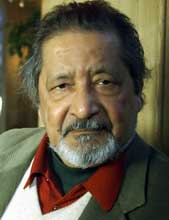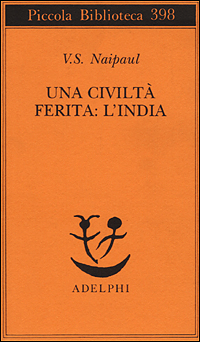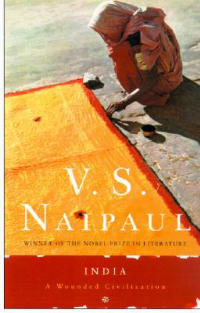|

Naipaul Vidiadhar Suraj
Naipaul, scrittore caribico (Trinidad 1932).
Di famiglia indiana bramina emigrata a Trinidad, nel 1950 ha abbandonato l'isola per stabilirsi in Gran Bretagna, dove ha completato i suoi studi presso l'Università di Oxford. Artefice di uno stile letterario collocabile tra il romanzo storico e l'autobiografia, Naipaul fin dai suoi primi racconti, The Mistic Masseur (1957; Il massaggio mistico), The Suffrage of Elvira (1958; Elezioni a Elvira), Miguel Street (1959), con una prosa raffinata, accompagnata da un'eleganza psicologica e da una sottile ironia, ha affrontato i temi del cosmopolitismo e dell'appartenenza, tratteggiando personaggi singolari, colti nel mezzo di una difficile transizione. In Guerrillas (1975) e in molti altri suoi libri emergono anche la concezione della politica come menzogna, le frustrazioni e le illusioni prodotte dalle ideologie progressiste. Mentre le storie dei suoi precedenti romanzi si svolgono nei Caraibi, A Bend on the River (1979; Alla curva del fiume) è ambientato in un Paese africano, segnando l'inizio di una fase più matura dello scrittore, sfociata poi in una maggiormente introspettiva con The Enigma of Arrival (1987; L'enigma dell'arrivo). In questo ultimo romanzo, di tipo autobiografico, Naipaul mette a confronto la sua cultura e quella anglosassone, facendo proprio un punto di vista distaccato e scettico, spettato sempre ai colonizzatori inglesi. Autore inoltre di alcuni libri di viaggio come The Middle Passage (1962; Il passaggio di mezzo) e Among the Believers: An Islamic Journey (1981; Fra credenti: viaggio nell'Islam), Naipaul ha pubblicato anche diversi saggi sull'India tra cui India:A Wounded Civilization (1977; Una civiltà ferita: l'India), feroce ritratto del Paese, e India: A Million Multinies Now (1990; Un milione di rivolte), riscoperta della patria dei suoi antenati e della sua cultura. Tra le altre opere si ricordano: A Way in the World (1990; Una via nel mondo), Beyond Belief (1998; Fedeli a oltranza), Half A Life (2001; Una vita a metà). Nel 2001 è stato insignito del premio Nobel per aver combinato narrativa percettiva e considerazioni incorruttibili in opere che costringono a vedere l'aspetto nascosto dei drammi storici. Nel 2004 ha pubblicato The Crocodiles of Yamoussoukro (I coccodrilli di Yamoussoukro).
Bibliografia Sintetica
Una via nel mondo. Una sequenza, Adelphi, 1995
In uno Stato libero, Adelphi, 1996
Una civiltà ferita: l'India, Adelphi, 1997
Un'area di tenebra, Adelphi, 1999
Fedeli a oltranza. Un viaggio tra i popoli convertiti all'Islam, Adelphi, 2001
Leggere e scrivere. Una testimonianza, Adelphi, 2002
La metà di una vita, Adelphi, 2002
I coccodrilli di Yamoussoukro, Adelphi, 2004
Una casa per Mr Biswas, Adelphi, 2005
Semi magici, Adelphi, 2007
Scrittori di uno scrittore, Adelphi, 2010
Generally considered the leading novelist of the English-speaking Caribbean, winner of the Nobel Prize in literature 2001. Naipaul's writings dealt with the cultural confusion of the Third World and the problem of an outsider, a feature of his own experience as an Indian in the West Indies, a West Indian in England, and a nomadic intellectual in a postcolonial world.
Naipaul has also arisen much controversy because of his politically incorrect views of the "half-made societies." He has constantly refused to avoid unwelcome topics, characterizing his role as a writer "to look and to look again, to re-look and rethink."
"The facts about Columbus have always been known. In his own writings and in all his actions his egoism is like an exposed deformity; he condemns himself. But the heroic gloss, which is not even his own, has come down through the centuries." (from 'Columbus and Crusoe', in The Overcrowded barracoon, 1972)
Vidiadhar Surajprasad Naipaul was born in a small town in Trinidad into a family of Indian Brahmin origin. His father, Seepersad Naipaul, was a correspondent for the Trinidad Guardian. He also published short stories. When Naipaul was six the family moved to Port of Spain, the capital. Seepersad Naipaul died of a heart attack in 1953 without witnessing the success of his son as a writer. He had encouraged Naipaul in his writing aspirations, telling him in a letter: "Don't be scared of being an artist. D. H. Lawrence was an artist through and through; and, for the time being at any rate, you should think as Lawrence. Remember what he used to say, 'Art for my sake.'" At the age of 18 he had written his first novel which was rejected by the publisher. Naipaul was educated at Queen's Royal College, Port of Spain, and in 1950 he won a scholarship to Oxford. In 1949, after having some pictures of himself taken for his application to the university,
Naipaul wrote to his elder sister: "I never knew my face was fat. The picture said so.
I looked at the Asiatic on the paper and thought that an Indian from India could look no more Indian than I did... I had hoped to send up a striking intellectual pose to the University people, but look what they have got." After a nervous breakdown he tried to commit suicide, but luckily the gas meter ran out. While at Oxford he met Patricia Hale; they married in 1955. She died in 1996 and Naipaul married Nadira Alvi, a divorced Pakistani journalist.
On graduation Naipaul started his career as a freelance writer. During this period Naipaul felt himself rootless, but found his voice as a writer in the mid-1950s, when he started to examine his own Trinidadian background. From 1954 to 1956 Naipaul was a broadcaster for the BBC's Caribbean Voices, and between the years 1957 and 1961 he was a regular fiction reviewer for the New Statesman.
Naipaul published his first books in the late 1950s, but they did not make much money for him or his publisher, André Deutsch Limited. However, he knew his value as a writer and refused to write a review for The Times Literary Supplement for their usual fee. Naipaul's novel THE MYSTIC MASSEUR (1957), about a bright young man, who dreams of becoming a famous writer, was adapted for the screen by Ismail Merchant.
MIGUEL STREET (1959) was a farewell to Port of Spain, Trinidad. The colorful characters of the sketches include Bogart, who got his name from the film Casablanca, B. Wordsworth who sells his poetry for four cents, and Man-man who in a real mystery to the people of Miguel Street. The narrator is a boy who grows up, starts to earn his own money and finally goes abroad to study. "I left them all and walked briskly towards the aeroplane, not looking back, looking only at my shadow before me, a dancing dwarf on the tarmac."
In later works Naipaul gave up comedic tones but in 1960 Charles Poore could write in his review of the book: "A comparison with "Porgy and Bess" has been suggested. The parallel has at least the merit of reminding us that the whole world is one. In that hospitable mood we might also remember Mark Twain's tales of life on the Mississippi. But Miguel Street, in Trinidad, is not really very much like Catfish Row, nor are reminders of nineteenth-century Missouri prevalent. What is true and, if you will, significant about Mr. Naipaul's book is that it presents a world of its own excellently." (The New York Times, May 5, 1960)
In 1961 appeared A HOUSE FOR MR BISWAS, often regarded as his masterpiece, which tells the tragicomic story of the search for independence and identity of a Brahmin Indian living in Trinidad. The protagonist, Mohun Biswas, was partly modelled after the author's father. Naipaul has said about this character and his father: "My father was a profounder man in every way. And his wounds are deeper than the other man can say. It's based on him, but it couldn't be the real man." Biswas has been unlucky from his birth, but all he wants is a house of his own - it is the solid basis of his existence. The story, which fuses social comedy and pathos, follows his struggle in variety of jobs, from sign painter to journalist, to his final triumph. Later Naipaul returned to his father in BETWEEN FATHER AND SON (1999), a record of their correspondence in the early 1950s.
In 1961 Naipaul received a grant from the Trinidad government to travel in the Caribbean. His first non-fiction book was THE MIDDLE PASSAGE (1962), in which he described his first revisiting of the West Indies. Its examination of racial tensions made black West Indians call Naipaul a 'racist.' From the wide period of travels in the 1960s and early 1970s in India, South-America, Africa, Iran, Pakistan, Malaysia and the USA, Naipaul produced among others INDIA: A WOUNDED CIVILIZATION (1977), and A BEND IN THE RIVER (1979), a pessimistic novel about Africa, proclaiming the corruptibility of mankind. The story is set in a country very like Zaïre or Uganda. Salim, the narrator is a Muslim, whose family, Indian traders, has lived in Africa hundreds of years. Salim sets up a shop in a town on the bend of the river and gains success, which has no future in a country ruled by the Big Man, president for life. Again Naipaul's protagonist is an
outsider, who realizes that his way of life is almost at its end and eventually he must give up everything. "The bush runs itself. But there is no place to go," says Selim's friend Ferdinand, when he rescues Selim from a jail. "The bush" is Naipaul
metaphor for the country and the whole third world. "Africa has no culture," Naipaul has said. Derek Walcott, the West Indian poet who won the Nobel prize for literature in 1992, noted: "If Naipaul's attitude toward Negroes, with its nasty little sneers... was turned on Jews, for example, how many people would praise him for his frankness?"
Since 1950 Naipaul has lived in Britain, but traveled extensively. His essays and travel writings are often negative, unsentimental explorations of West Indian society as in THE MIDDLE PASSAGE (1962). "The steel band used to be regarded as a high manifestation of West Indian culture, but it was a sound I detested." AMONG THE BELIEVERS: AN ISLAMIC JOURNEY (1981) was accused by Muslim readers of narrow and selective vision of Islam. Naipaul searches the sources of the new Islam - and the ideological rage. "Islam sanctified rage - rage about the faith, political rage: one could be like the other. And more than once on this journey I had met sensitive men who were ready to contemplate great convulsions." (from Among the Believers) Naipaul's latest travel books include BEYOND BELIEF: ISLAMIC EXCURSIONS
AMONG THE CONVERTED PEOPLES (1998), intimate portraits from his journeys to the non-Arab Islamic countries of Indonesia, Iran, Pakistan, and Malaysia. Naipaul tries to understand the fundamentalist fervour that have marked the Western image of the region. "There probably has been no imperialism like that of Islam and the Arabs," he writes. In Iran he meets war veterans, who express their disillusionment and their sense of being manipulated by the mullahs, and in Indonesia he meets his former friend, who opposed the Suharto regime, and later became an establishment figure, an advocate of an Islamicist future. On his first visit to India since he was awarded the Nobel Prize, Naipaul said: "We are not here to celebrate the antiquity of literature in India, but to celebrate modern writing."
In his semi-autobiographical novel THE ENIGMA OF ARRIVAL (1987) Naipaul depicts a writer of Caribbean origin, who finds joys of homecoming in England after wandering years - during which world stopped being a colony for him. Central themes in Naipaul's works are damaging effects of colonialism upon the people of the Third World, but he doesn't believe in the imported ideas of revolutionaries or the ability of the former colonies to avoid mistakes made by the Western consumer societies. As a writer he has been compared to Joseph Conrad because of similar pessimistic portrayal of human nature and the themes of exile and alienation. "Barbarism in India is very powerful because it has a religious side," he once stated. In the essay 'Conrad's Darkness' (pub. in THE RETURN OF EVA PERON, 1980) Naipaul sees his own background as "one of the Conradian dark places of the earth."
In the 1990s Naipaul concentrated on non-fiction. In 1994 appeared his long-awaited novel, A WAY IN THE WORLD, an autobiography and a fictional history of colonialism, presenting stories from the times of Sir Walter Raleigh to the nineteenth-century revolutionary Franciso Miranda. In HALF A LIFE (2001) the protagonist is Willie Somerset Chandran, born in India in the 1930s. His second name he has got from the English writer Somerset Maugham, who has met his father. Willie moves to London, drifts in bohemian circles, publishes a book, marries Ana, a woman of mixed African descent, and moves with her to Africa, to her family estate. Willie has problems to come in terms with himself, as the son of a Brahman, who has married un "untouchable." His father is a rebel who ends at a monastery. Willie rebels against his own background and the wishes of his father, with whom he has more in common than he admits. In his wife's home country, in which colonial system is breaking down, Willie is also an outsider. After eighteen years he decides to leave her, and find his true identity. He has lived half a life, a shadow life, but Naipaul doesn't tell will happen to him. Willie's existential search continues and the rest of his story is left open.
Willie's decision parallels with the history of the relationship between the American writer Paul Theroux and Naipaul. Theroux depicted his decades long friendship with Naipaul in Sir Vidia's Shadow (1998). In this angry and unforgiving book Theroux eventually is rejected by Naipaul and he realizes he has come out Naipaul's shadow, he is free. Theroux considered earlier the older writer as his mentor but the friendship ended in breakup, which Theroux sealed with his bitter accusations. "I had admired his talent. After a while I admired nothing else. Finally I began to wonder about his talent, seriously to wonder, and doubted it when I found myself skipping pages in his more recent books. In the past I would have said the fault was mine. Now I knew that he could be the monomaniac in print that he was in person." (from Sir Vidia's Shadow) - Among Naipaul's several literary awards is the Booker Prize for IN A FREE STATE (1971). He was knighted in 1989 and in 1993 he won the first David Cohen British Literature Prize for "lifetime achievement by a living British writer". Naipaul's manuscripts and extensive archives have been deposited in the University of Tulsa. At a speech in October 2004 Naipaul announced that MAGIC SEEDS (2004) may be his last novel.
"I have no faith in the survival of the novel," he said. |




 Una civiltà ferita: l'India
Una civiltà ferita: l'India
